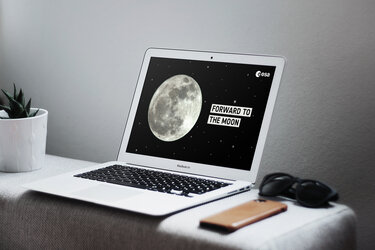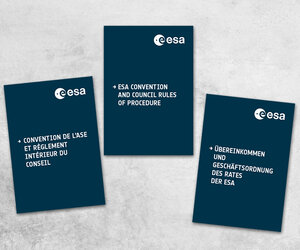Behind the scenes: This is ESA poster
This is ESA's poster is the visual component of the brochure, which takes you on a journey through ESA’s activities, showcasing how ESA is making space work for the benefit of humankind. The poster encapsulates these achievements in one dynamic image. But integrating our diverse space activities, including past, present and future missions, into one cohesive colour poster was a challenge. In this interview, the poster’s designer explains how he achieved this and where he found his inspiration.
The poster represents some of ESA’s most influential space missions spanning the past 30 years, as well as some of the ambitious science and discovery programmes planned for the next decade. The brief was given to designer Attilio Brancaccio, who also designed ESA’s Columbus anniversary posters and our collection of Space Safety and Security images.
He explains that the initial approach to designing the poster was very much a collaborative process with the ESA team: “Initially we experimented with greater separation of the different areas representing the past, present and future missions, in terms of composition and layout. However, the main challenge was to create fluidity between the storylines and to get it to work in a balanced way.”
The next approach was to create a visual timeline: “Of course, it’s not an exact timeline because there are areas where the past and present merge together. For example, the International Space Station (ISS) is shown near to Orion, which is an upcoming mission and above we have Rosetta, which is a mission that ended in 2016.”
To create a cohesive image, diagonal lines were used to separate the different types of missions, while maintaining a fluid and dynamic feel. “If you look at the poster, you see there are five different bands – but you see it as just one design,” says Attilio. He adds that he then focused on balancing the different elements to find the best way to visually represent ESA’s story and heritage.
The concept
On the left-hand side of the poster, three figures represent an astronaut, a scientist and an engineer, who gaze out across space. The female astronaut, who wears a patch containing the flags of ESA’s 27 Member States and Associate Members, looks upwards towards the ringed planet Saturn, where the Cassini-Huygens mission is orbiting. The light from her EVA spacesuit shines on the spacewalker in the next section of the poster, who is attached to the ISS, flying 400 km above the green and blue shapes of planet Earth.
Just above the ISS, the Orion spacecraft can be seen on a future journey to the Moon. Rosetta and the icy grey comet 67P/Churyumov-Gerasimenko are seen in the upper central area of the poster. And in the next panel, we see the Ariane and Vega family of launchers, together with Space Rider, zoom up towards the top-right corner.
To the right of the rockets, a scene shows a futuristic Moon village, complete with the artist’s impression of a moon lander. This was inspired by the Prospect mission, a partnership between ESA and Roscosmos. In the same scene, BepiColombo can be seen on its journey to Mercury.
In the lower right corner, Rosalind Franklin the ExoMars Rover explores an imagined Martian city on the Red Planet, while the Mars Sample Return mission can be seen in the background heading back to Earth on board the Mars Ascent Vehicle.
Design inspiration
So what was the designer’s technique and inspiration for creating this image? After researching images of the ESA missions and with input from the ESA editor and designers, Attilio then sketched different ideas and compositions. One of the challenges was to depict the past missions in a realistic way, while some artistic licence was needed to imagine the future programmes. For example, the images of the Rosetta spacecraft and BepiColombo had to reflect the actual missions, while the Moon village and the futuristic Martian city required some creative thinking.
The final image is the result of experimentation with layout and colour, both on paper and using digital design tools. The designer explains: “This process enabled me to find a balanced placement for the different images. Once we had agreed on the style of the illustration and the composition, then I started to create the final design with professional illustration software.”
One of the key factors in creating a poster that really encapsulates the spirit of ESA was to find the perfect match between theme and style. Posters from the golden age of space and Moon discovery were a strong influence. Attilio was then able to add a 21st century feel using a fresh, modern colour palette. He says: “I found myself inspired by the style of the 1960s and 70s era of US and Russian space missions. During those years there were amazing designs about space using the visual element to create the dream of future space exploration.” More than half a century later, ESA is more focused than ever on making this dream a reality.


The designer's hand-drawn sketches show the creative development behind the poster












